Piping and plumbing fitting
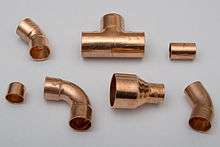
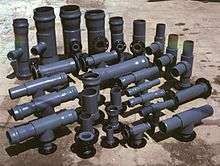
A fitting is used in pipe systems to connect straight pipe or tubing sections, adapt to different sizes or shapes and for other purposes, such as regulating {or measuring) fluid flow. "Plumbing" is generally used to describe the conveyance of water, gas, or liquid waste in domestic or commercial environments; "piping" is often used to describe the high-performance (high-pressure, high-flow, high-temperature or hazardous-material) conveyance of fluids in specialized applications. "Tubing" is sometimes used for lighter-weight piping, especially those flexible enough to be supplied in coiled form.
Fittings (especially uncommon types) require money, time, materials and tools to install, and are an important part of piping and plumbing systems.[1] Valves are technically fittings, but are usually discussed separately.
Standards
Standard codes are followed when designing (or manufacturing) a piping system. Organizations which promulgate piping standards include:
- ASME – American Society of Mechanical Engineers
- A112.19.1 Enameled cast-iron and steel plumbing fixtures standards
- A112.19.2 Ceramic plumbing fixtures standard
- ASTM International – American Society for Testing and Materials
- API – American Petroleum Institute
- AWS – American Welding Society
- AWWA – American Water Works Association
- MSS – Manufacturers Standardization Society
- ANSI – American National Standards Institute
- NFPA – National Fire Protection Association
- EJMA – Expansion Joint Manufacturers Association
- CGA – Compressed Gas Association
Pipes must conform to the dimensional requirements of:
- ASME B36.10M – Welded and seamless wrought-steel pipe
- ASME B36.19M – Stainless-steel pipe
- ASME B31.3 2008 – Process piping
- ASME B31.4 XXXX – Power piping
The B31.3 and B31.4 codes have requirements for piping found in petroleum refineries; chemical, pharmaceutical, textile, paper, semiconductor, and cryogenic plants, and related processing plants and terminals. These codes specify requirements for materials and components, design, fabrication, assembly, erection, examination, inspection and testing of piping. The codes are applicable to piping for all fluids, including raw, intermediate and finished chemicals; petroleum products; gas, steam, air and water; fluidized solids; refrigerants, and cryogenic fluids.
Materials
The material with which a pipe is manufactured is often the basis for choosing a pipe. Materials used for manufacturing pipes include:
- Carbon (CS) and galvanized steel
- Impact-tested carbon steel (ITCS)
- Low-temperature carbon steel (LTCS)
- Stainless steel (SS)
- Malleable iron
- Non-ferrous metals (includes copper, inconel, incoloy and cupronickel)
- Non-metallic (includes acrylonitrile butadiene styrene (ABS), fibre-reinforced plastic (FRP), polyvinyl chloride (PVC), high-density polyethylene (HDPE) and toughened glass)
- Chrome-molybdenum (alloy) steel — Generally used for high-temperature service
The bodies of fittings for pipe and tubing are most often the same base material as the pipe or tubing connected: copper, steel, PVC, chlorinated polyvinyl chloride (CPVC) or ABS. Any material permitted by the plumbing, health, or building code (as applicable) may be used, but it must be compatible with the other materials in the system, the fluids being transported and the temperature and pressure inside (and outside) the system. Brass or bronze fittings are common in copper piping and plumbing systems. Fire hazards, earthquake resistance and other factors also influence the choice of fitting materials.
Gaskets
Gaskets are mechanical seals, usually ring-shaped, which seal flange joints.[2] Gaskets vary by construction, materials and features. Commonly-used gaskets are non-metallic (ASME B 16.21), spiral-wound (ASME B 16.20) and ring-joint (ASME B 16.20). Non-metallic gaskets are used with flat- or raised-face flanges. Spiral-wound gaskets are used with raised-face flanges, and ring-joint gaskets are used with ring-type joint (RTJ) flanges. Stress develops between an RTJ gasket and the flange groove when the gasket is bolted to a flange, leading to plastic deformation of the gasket.[3]
Gender
Piping or tubing is usually inserted into fittings to make connections. Connectors are assigned a gender, abbreviated M or F. An example of this is a "3/4-inch female adapter NPT", which would have a corresponding male connection of the same size and thread standard (in this case, NPT).
Common piping and plumbing fittings
Elbow
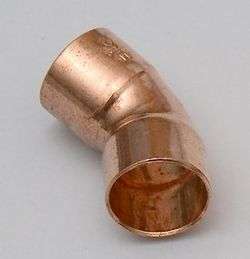
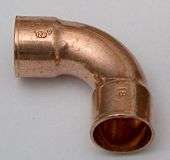
An elbow is installed between two lengths of pipe (or tubing) to allow a change of direction, usually a 90° or 45° angle; 22.5° elbows are also available. The ends may be machined for butt welding, threaded (usually female) or socketed. When the ends differ in size, it is known as a reducing (or reducer) elbow.
Elbows are categorized by design. The radius of a long-radius (LR) elbow is 1.5 times the pipe diameter. In a short-radius (SR) elbow, the radius equals the pipe diameter. Ninety-, 60- and 45-degree elbows are also available.
A 90-degree elbow, also known as a "90 bend", "90 ell" or "quarter bend", attaches readily to plastic, copper, cast iron, steel and lead and attaches to rubber with stainless-steel clamps. Available materials include silicone, rubber compounds, galvanized steel and nylon. It is primarily used to connect hoses to valves, water pumps and deck drains. A 45-degree elbow, also known as a "45 bend" or "45 ell", is commonly used in water-supply facilities, food, chemical and electronic industrial pipeline networks, air-conditioning pipelines, agriculture and garden production and solar-energy facility piping.
Most elbows are available in short- or long-radius versions. Short-radius elbows have a center-to-end distance equal to the Nominal Pipe Size (NPS) in inches, and long-radius elbows are 1.5 times the NPS in inches. Short elbows, widely available, are typically used in pressurized systems.
Long elbows are used in low-pressure gravity-fed systems and other applications where low turbulence and minimum deposition of entrained solids are of concern. They are available in acrylonitrile butadiene styrene (ABS plastic), polyvinyl chloride (PVC), chlorinated polyvinyl chloride (CPVC) and copper for DWV systems, sewage and central vacuums.
Coupling
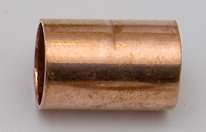
A coupling connects two pipes. If their sizes differ, the fitting is known as a reducing coupling, reducer or an adapter. There are two types of couplings: slip and regular.
Union
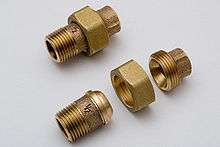
A union, similar to a coupling, allows the convenient disconnection of pipes for maintenance or fixture replacement. Although a coupling requires solvent welding, soldering or rotation (threaded couplings), a union allows easy connection and disconnection. It consists of three parts: a nut, a female end and a male end. When the female and male ends are joined, the nut seals the joint. Unions are a type of flange connector.
Dielectric unions, with dielectric insulation, separate dissimilar metals (such as copper and galvanized steel) to prevent galvanic corrosion. When two dissimilar metals are in contact with an electrically-conductive solution (tap water is conductive), they form a battery generating a voltage by electrolysis. When the metals are in direct contact with each other, the electric current from one to the other moves ions from one to the other; this dissolves one metal, depositing it on the other. A dielectric union breaks the electrical path with a plastic liner between its halves, limiting galvanic corrosion. Rotary unions allow rotation of one of the joined parts.
Reducer
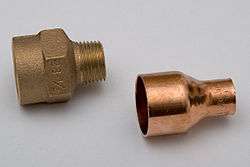
A reducer allows for a change in pipe size to meet hydraulic flow requirements of the system or adapt to existing piping of a different size. Although reducers are usually concentric, eccentric reducers are used as needed to maintain the top- or bottom-of-pipe level.
Tee
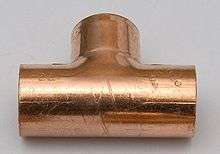
A tee, the most common pipe fitting, is used to combine (or divide) fluid flow. It is available with female thread sockets, solvent-weld sockets or opposed solvent-weld sockets and a female-threaded side outlet. Tees can connect pipes of different diameters or change the direction of a pipe run. Available in a variety of materials, sizes and finishes, they are used to transport two-fluid mixtures. Tees may be equal or unequal in size, with equal tees the most common.
Cross
Crosses, also known as four-way fittings, cross branch lines. A cross has one inlet and three outlets (or vice versa), and often have solvent-welded socket or female-threaded ends. Cross fittings may stress pipes as temperatures change, because they are at the center of four connection points. A tee is steadier than a cross; it behaves like a three-legged stool, and a cross behaves like a four-legged stool. Geometrically, any three non-collinear points define a plane; three legs are inherently stable. Crosses are common in fire sprinkler systems (where stress caused by thermal expansion is not generally an issue), but not in plumbing. One cross is more expensive than two tees.
Cap and plug
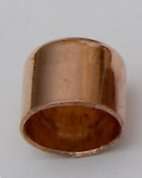
Caps and plugs, usually liquid- or gas-tight, cover the end of a pipe. A cap attaches to the male thread of a pipe. It may have a solvent-weld socket end or a female-threaded end. In threaded plumbing systems, the cap has female threads. Industrial caps may be round, square, rectangular, U- or I-shaped, and may have a handgrip. If a solvent-weld cap is used to provide for a future connection point, several inches of pipe must be left before the cap; when the cap is cut off for the future connection, enough pipe must remain to allow a new fitting to be glued onto it.
A plug fits inside the fitting to which it is mated. In a threaded plumbing system, plugs have male threads. There are a number of plug types: mechanical, pneumatic-disk, single-size pneumatic rubber, multi-size pneumatic and flow-through, and high-pressure.
Nipple

A nipple is a short stub of pipe, usually male-threaded steel, brass, chlorinated polyvinyl chloride (CPVC) or copper (occasionally bare copper), which connects two other fittings. Nipples are commonly used for plumbing and hoses.
Barb
A barb (or hose barb), which connects flexible hose or tubing to pipes, typically has a male-threaded end which mates with female threads. The other end of the fitting has a single- or multi-barbed tube—a tapered stub with ridges, which is inserted into a flexible hose. An adjustable worm drive screw clamp (or other type of clamp) is often added, to keep the hose from slipping off the barbed tube. Barb fittings can be made of brass for hot-water applications, and plastic may be used for cold water; brass is considered more durable for heavy-duty use. The barb fitting may be elbow-shaped or straight.
Valve
Valves stop (or regulate) the flow of liquids or gases. They are categorized by application, such as isolation, throttling and non-return. Valves are available in a number of types, based on design and purpose:
- Gate, plug or ball valves – Isolation
- Globe valve – Throttling
- Butterfly or diaphragm valves – Isolation and throttling
- Check valve – Preventing reverse flow (non-return)
- Needle valve – Controlling flow rate
Drain-waste-vent (DWV) and related fittings

Because they operate at low pressure and rely on gravity to move fluids (and entrained solids), drain-waste-vent systems use fittings whose interior surfaces are as smooth as possible. The fittings may be "belled" (expanded slightly in diameter) or otherwise shaped to accommodate the insertion of pipe or tubing without forming a sharp interior ridge that might catch debris or accumulate material and clog.[4] This smoothness makes it easier to "snake out" or "rod out" a clogged pipe with a plumber's snake.
Underground piping systems for landscaping drainage or the disposal of stormwater or groundwater also use low-pressure gravity flow. Fittings for these systems are larger-scale DWV fittings. With high peak-flow volumes, the design and construction of these systems resemble those of sewers.
Fittings for central vacuum systems, similar to DWV fittings, are usually of thinner and lighter construction because the weight of the materials conveyed is less. Vacuum-system designs share with DWV designs the need to eliminate internal ridges, burrs, sharp turns or other obstructions which might create clogs.
Slip-joint fitting
Slip-joint fittings are frequently used in kitchen, bathroom and tub drainage systems.[5] They include a detached (movable) slip nut and slip-joint washer; the washer is made of rubber or nylon.[6] An advantage of this of fitting is that the pipe it is connecting to does not need to be cut to fit precisely; the slip joint can attach within a range of the end of the inserting pipe. Many slip fittings may be tightened by hand for easier entry to residential drainpipe systems (for example, to clean out a trap or access a drain line past a trap).
Sweep elbow
DWV elbows are usually long-radius ("sweep") types. To reduce flow resistance and solid deposits when the direction of flow is changed, they use a shallow curve.[7] A well-designed system will often use two 45° elbows instead of one 90° elbow (even a sweep 90° elbow) to reduce flow disruption as much as possible.
Central vacuum system inlet fittings are intentionally designed with a tighter radius of curvature than those of other bends in the system. If vacuumed debris becomes stuck it will jam at the inlet, where it is easy to find and remove.
Closet flange
A closet flange (the drainpipe flange to which a flush toilet is attached) is a specialized flange designed to be flush with the floor, allowing a toilet to be installed above it.
Clean-out
Clean-outs are fittings with removable elements, allowing access to drains without the removal of plumbing fixtures. They are used to allow an auger (or plumber's snake) to clean out a plugged drain. Since clean-out augers are limited in length, clean-outs should be placed in accessible locations at regular intervals throughout a drainage system (including outside the building). Minimum requirements are typically at the end of each branch in piping, just ahead of each water closet, at the base of each vertical stack and inside and outside the building in the main drain or sewer. Clean-outs usually have screw-on caps or screw-in plugs. They are also known as "rodding eyes", because of the eye-shaped cover plates often used on external versions.
Double-tapped bushing
A double-tapped bushing is a fitting with opposing threads on the inside of the bushing.
Trap primer
A trap primer injects water into a trap, maintaining a water seal to keep sewer gas out of buildings. It must be installed in an easily-accessible place for adjustment, replacement and repair. A trap primer, a specialized valve, is usually connected to a clean-water supply in addition to a DWV system.[8] Because of the dual connection, it must be designed to resist the accidental backflow of contaminated water.
Combo tee
A combination tee (combo tee, combo wye, tee wye, long-sweep wye or combi) is a tee with a gradually-curving central connecting joint: a wye plus an additional 1/8 bend (45°), combined in one 90° unit. It is used in drains for a smooth, gradually-curving path to reduce the likelihood of clogs, to ease the pushing of a plumber's snake through a drain system and to encourage water flow in the direction of the drain.
Sanitary tee
A sanitary tee has a curved center section. In drainage systems, it is primarily used to connect horizontal drains (including fixture trap arms) to vertical drains. The center connection is generally to the pipe leading to a trap (the trap arm). It must not connect a vertical drain to a horizontal drain, because of the likelihood that solids will accumulate at the bottom of the junction and cause a blockage.
Baffle tee
Also called a tee with diverter baffle,[9] a waste tee or an end-outlet tee, it typically connects waste lines before they enter the trap and has a baffle to keep water from one waste pipe from entering the other at the connection.[10]
Double sanitary tee (sanitary cross)
This fitting differs from a standard cross in that two of the ports have curved inlets. Although it has been used in the past for connecting the drains of back-to-back fixtures (such as back-to-back sinks), some current codes—including the 2006 Uniform Plumbing Code in the United States—prohibit the use of this fitting for that purpose and require a double-fixture fitting (double combination wye) to minimize the sides flowing into each other.
<span id="Wye ("Y") fitting">Wye (Y) fitting
A fitting with three openings, a wye joins (or creates) branch lines. It is a waste-fitting tee in which the side inlet pipe enters at a 45-degree angle, or an angle other than 90 degrees. A standard wye is a Y-shaped fitting which allows one pipe to be joined to another at a 45 degree angle.
Wyes are similar to tees, except for the angling of the branch line to reduce friction and turbulence. They are commonly used to attach a vertical drainpipe to a horizontal one. The connection is typically at a 45-degree, rather than 90 degrees; if a branch turns out further at the end to 90 degrees (perpendicular), the fitting becomes a combo tee.[11] Wyes and combo wyes follow a long-sweep pattern[12] relative to sanitary tees and other short-sweep bends, which have a smaller radius and require less space. A wye may also be used to split a branch line equally in two directions, such as the splitting of a main line into two smaller branches.
Wyes also have industrial applications. Although low-priced wyes are often spot-welded, industrial-strength wyes are flash-welded at each seam. In long-distance pipeline applications, a wye is used for pigging to maintain flow.
Side inlet TY
This fitting (also known as a "bungalow fitting" or a "cottage fitting") is a sanitary T that allows two trap arms to be connected at the same level. A toilet is the main connection, with the option of a right or left-hand outlet to the 3" inlet with a choice of 1-1/2" or 2" in size. It is for keeping stack-vented fixtures high to the joist space and thus conserving head room in a basement. As the water closet must be the lowest fixture, the smaller side outlet (usually used to connect the bathtub trap arm) enters slightly above the larger connection.
Hydraulic fittings
Hydraulic systems use high fluid pressure, such as the hydraulic actuators for bulldozers and backhoes. Their hydraulic fittings are designed and rated for much greater pressure than that experienced in general piping systems, and they are generally not compatible with those used in plumbing. Hydraulic fittings are designed and constructed to resist high-pressure leakage and sudden failure.
Connection methods
Much of the work of installing a piping or plumbing system involves making leakproof, reliable connections, and most piping requires mechanical support against gravity and other forces (such as wind loads and earthquakes) which might disrupt an installation.[13] Depending on the connection technology and application, basic skills may be sufficient, or specialized skills and professional licensure may be legally required.
Fasteners
Fasteners join, or affix, two or more objects. Although they are usually used to attach pipe and fittings to mechanical supports in buildings, they do not connect the pipes to each other. Fasteners commonly used with piping are a stud bolt with nuts (usually fully threaded, with two heavy, hexagonal nuts); a machine bolt and nut; or a powder-actuated tool (PAT) fastener (usually a nail or threaded stud, driven into concrete or masonry).
Threaded pipe
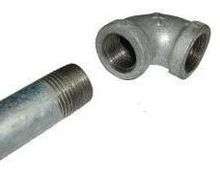
A threaded pipe has a screw thread at one or both ends for assembly. Steel pipe is often joined with threaded connections; tapered threads are cut into the end of the pipe, sealant is applied in the form of thread-sealing compound or thread seal tape (also known as PTFE or Teflon tape) and the pipe is threaded into a threaded fitting with a pipe wrench.
Threaded steel pipe is widely used in buildings to convey natural gas or propane fuel, and is a popular choice in fire sprinkler systems due to its high heat resistance. in older installations, threaded brass pipe was similarly used, and was considered superior to steel for drinking water, because it was more resistant to corrosion.
Assembling threaded steel pipe takes skill and planning to allow lengths of pipe to be screwed together in sequence. Most threaded-pipe systems require the use of some pipe-union fittings in final assembly.
Solvent welding
.jpg)
A solvent is applied to PVC, CPVC, ABS or other plastic piping to partially dissolve and fuse the adjacent surfaces of piping and fitting. Solvent welding is usually used with a sleeve-type joint to connect pipe and fittings made of the same (or compatible) material.
Unlike metal welding, solvent welding is relatively easy to perform (although care is needed to make reliable joints). Solvents typically used for plastics are usually toxic and may be carcinogenic and flammable, requiring adequate ventilation.
Soldering
To make a solder connection, a chemical flux is applied to the inner sleeve of a joint and the pipe is inserted. The joint is then heated using a propane or MAPP gas torch, solder is applied to the heated joint and the molten solder is drawn into the joint by capillary action as the flux vaporizes. "Sweating" is a term sometimes used to describe the soldering of pipe joints.
Where many connections must be made in a short period of time (such as plumbing of a new building), solder is quicker and less expensive joinery than compression or flare fittings. A degree of skill is needed to make a number of reliable soldered joints quickly. If flux residue is thoroughly cleaned, soldering can produce a long-lasting connection at low cost. However, the use of an open flame for heating joints can present fire and health hazards to building occupants and requires adequate ventilation.
Brazing
Brazing is a thermal joining process in which two pieces of base metal are joined by a molten brazing filler metal which is drawn between them by capillary action. It is used to join most metals and alloys commonly used in engineering. A brazing filler metal has a very high melting point, but lower than the melting point of the metals being joined. Although it is closely related to soldering, higher temperatures are used. Brazing can join pipes, rods and metal pieces which fit against each other, without large gaps; it can join tungsten carbide, ceramics and similar non-metallic materials.
Well-brazed joints are as strong as their parent-metal pieces and can withstand demanding service. With smooth, neat fillets, they have good electrical conductivity.
Welding
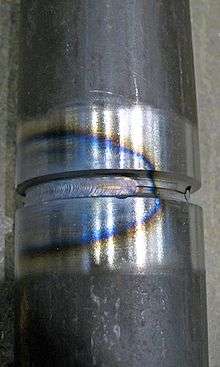
The welding of metals differs from soldering and brazing in that the joint is made without adding a lower-melting-point material (e.g. solder); instead, the pipe or tubing material is partially melted and the fitting and piping are directly fused. This generally requires that the piping and fitting are the same (or compatible) material. Proper ventilation is essential to remove metal fumes from welding operations, and personal protective equipment must be worn.
Properly welded joints are considered reliable and durable. Pipe welding is often performed by specially licensed workers whose skills are tested periodically. For critical applications, every joint is tested with nondestructive methods. Because of the skills required, welded pipe joints are usually restricted to high-performance applications such as shipbuilding and in chemical and nuclear reactors.
Compression fittings
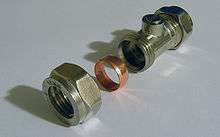
Compression fittings (sometimes called lock-bush fittings) consist of a tapered, concave conical seat, a hollow, barrel-shaped compression ring (sometimes called a ferrule) and a compression nut which is threaded onto the body of the fitting and tightened to make a leakproof connection. Typically made of brass or plastic, stainless steel or other materials may be used.
Although compression connections are less durable than sweated connections, they are easy to install with simple tools. However, they take longer to install than sweated joints and sometimes require re-tightening to stop slow leaks which develop over time.
Push-to-pull compression fittings
Flare fittings
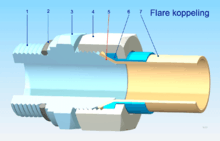
Flared connectors should not be confused with compression connectors, since they are generally not interchangeable. Lacking a compression ring, they use a threaded nut instead. A specialized flaring tool is used to enlarge tubing into a bell shape matching the tapered, projecting conical shape of the flare fitting. The flare nut, which has previously been installed over the tubing, is then tightened onto the fitting. Flare connectors are typically made of brass or plastic, but stainless steel or other materials may be used.
Although flare connections are labor-intensive, they are durable and reliable. Considered more secure against leaks and sudden failure, they are used in hydraulic brake systems.
Flange fittings
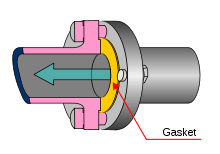
Flange fittings are generally used for connections to valves, inline instruments or equipment nozzles. Two surfaces are joined tightly together with threaded bolts, wedges, clamps, or other means of applying high compressive force.[14] Although a gasket, packing or O-ring may be installed between the flanges to prevent leakage, it is sometimes possible to use only a special grease or nothing at all (if the mating surfaces are precisely formed). Flanges are rated at 150, 300, 400, 600, 900, 1500 and 2500 lbs or 10, 15, 25, 40, 64, 100 and 150 bars of pressure. Various types of flanges are available, depending on construction. Flanges used in piping (orifice, threaded, slip-on, blind, weld neck, socket, lap-joint and reducing) are available with a variety of facings, such as raised, flat and ring-joint.
Slip-on flanges are slipped over the pipe and welded to provide strength and prevent leakage. This flange is less expensive than a weld neck and requires less accuracy when cutting pipe to length. Blind flanges are used to shut off a piping system or opening. Its design permits easy access for inspection.
A weld neck flange is joined to a piping system by butt welding. Although its long neck makes it expensive, it reduces stress on piping. The neck (or hub) distributes stress between the base of the flange and the wall at the weld; turbulence and erosion are reduced due to the matching size of the pipe and flange.
A socket flange appears similar to a slip-on flange, but its bore is counter-bored to accept pipe. A fillet weld around the hub of the flange attaches the flange to the pipe, with an interval weld added in high-stress applications. It is most frequently used in high-pressure systems, such as hydraulic and steam lines.
A lap-joint flange is similar to a slip-on, with room at the intersection of the bore and the flange face for a lap stub end. The face of the stub end conforms to the gasket face of the flange. It is used where sections of piping need to be dismantled quickly and easily for inspection or replacement. Although flange fittings are bulky, they perform well in demanding applications such as large water supply networks and hydroelectric systems.
Mechanical fittings
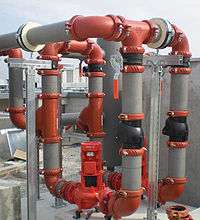
Manufacturers such as Victaulic and Grinnell produce sleeve-clamp fittings which are replacing flange connections. They attach to the end of a pipe segment in circumferential grooves pressed (or cut) around the end of the pipe to be joined. Mechanical connectors, widely used on larger steel pipes, can also be used with other materials.
The chief advantage of these connectors is that they can be installed in the field after cutting the pipe to length. This is faster than flange connections, which must be factory- or field-welded to pipe segments. However, mechanically-fastened joints are sensitive to residual and thickness stresses caused by dissimilar metals and temperature changes.
A grooved fitting, also known as a grooved coupling, has four elements: grooved pipe, gasket, coupling housing and nuts and bolts. The groove is made by cold-forming (or machining) a groove at the end of a pipe. A gasket encompassed by coupling housing is wrapped around the two pipe ends, with the coupling engaging the groove; the bolts and nuts are tightened with a socket or impact wrench. The installed coupling housing encases the gasket and engages the grooves around the pipe to create a leakproof seal in a self-restrained pipe joint. There are two types of grooved coupling; a flexible coupling allows a limited amount of angular movement, and a rigid coupling does not allow movement and may be used where joint immobility is required (similar to a flange or welded joint).
Crimped or pressed fittings
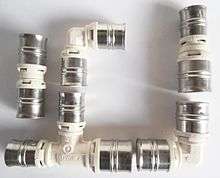
Crimped or pressed connections use special fittings which are permanently attached to tubing with a powered crimper. The fittings, manufactured with sealant, slide over the tubing to be connected. High pressure is used to deform the fitting and compress the sealant against the inner tubing, creating a leakproof seal.
The advantages of this method are durability, speed, neatness and safety. The crimped fitting is designed with copper tubing, without flux or filler metal. The connection can be made even when the tubing is wet. Although they are suitable for drinking-water pipes and other hot-and-cold systems (including central heating), they are substantially more expensive than sweated fittings.
See also
| Wikimedia Commons has media related to fitting. |
References
- ↑ "Use Proper Plumbing Tools To Avoid Flushing Money Down The Drain". Bangor Daily News. October 25, 1996. Retrieved December 26, 2013.
- ↑ "Proper Replacement Of Gaskets Important". The Victoria Advocate. Feb 26, 1963. Retrieved December 26, 2013.
- ↑ "Gaskets General – Non-Metallic Flat, Spiral Wound Gaskets, Camprofile Gaskets, Metal-Jacketed Gaskets and Metallic Gaskets -". wermac.org.
- ↑ "You Can Fix Plumbing Problems With The Right Equipment .". The Daily Courier. October 20, 1996. Retrieved December 27, 2013.
- ↑ "Slip-Joint". freeonlineplumber.com.
- ↑ "plumbing – In slip joints, what's the difference between rubber and nylon washers? - Home Improvement Stack Exchange". stackexchange.com.
- ↑ "plumbing – How do I make my bathroom pipes more practical? - Home Improvement Stack Exchange". stackexchange.com.
- ↑ "Advise Check Of Drains". Lodi News-Sentinel. Oct 4, 1937. Retrieved 2013-12-26.
- ↑ "Disposal won't drain". homerepairforum.com.
- ↑ http://www.nettally.com/palmk/GDplumbing.html
- ↑ "plumbing – combo tee vs. tee wye – Home Improvement Stack Exchange". stackexchange.com.
- ↑ http://www.ci.camarillo.ca.us/docs/Drainage%20Piping.pdf
- ↑ "New Methods Simplify Plumbing Problems". Schenectady Gazette. Sep 26, 1933. Retrieved December 26, 2013.
- ↑ "Seal Between Flange, Toilet When Troubleshooting In Leaky bathrooms". Northwest Columbus News -. September 4, 2002. Retrieved December 27, 2013.
External links
- International Association of Plumbing and Mechanical Officials
- International Code Council
- the American Society for Testing and Materials
- Society of Piping Engineers and Designers — Society of piping professionals with many resources and technical information
- Standard SS/CS pipe dimensions calculator